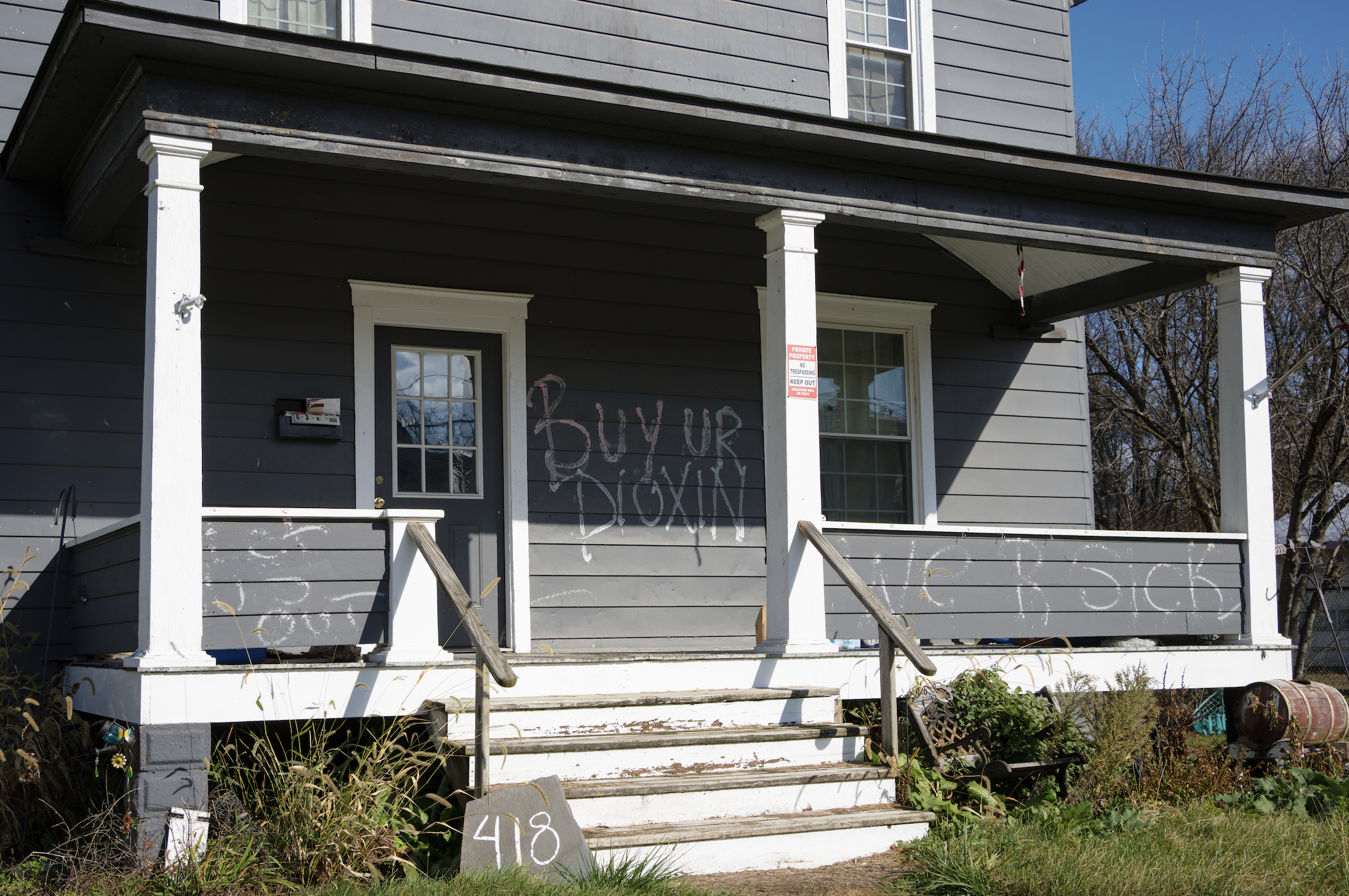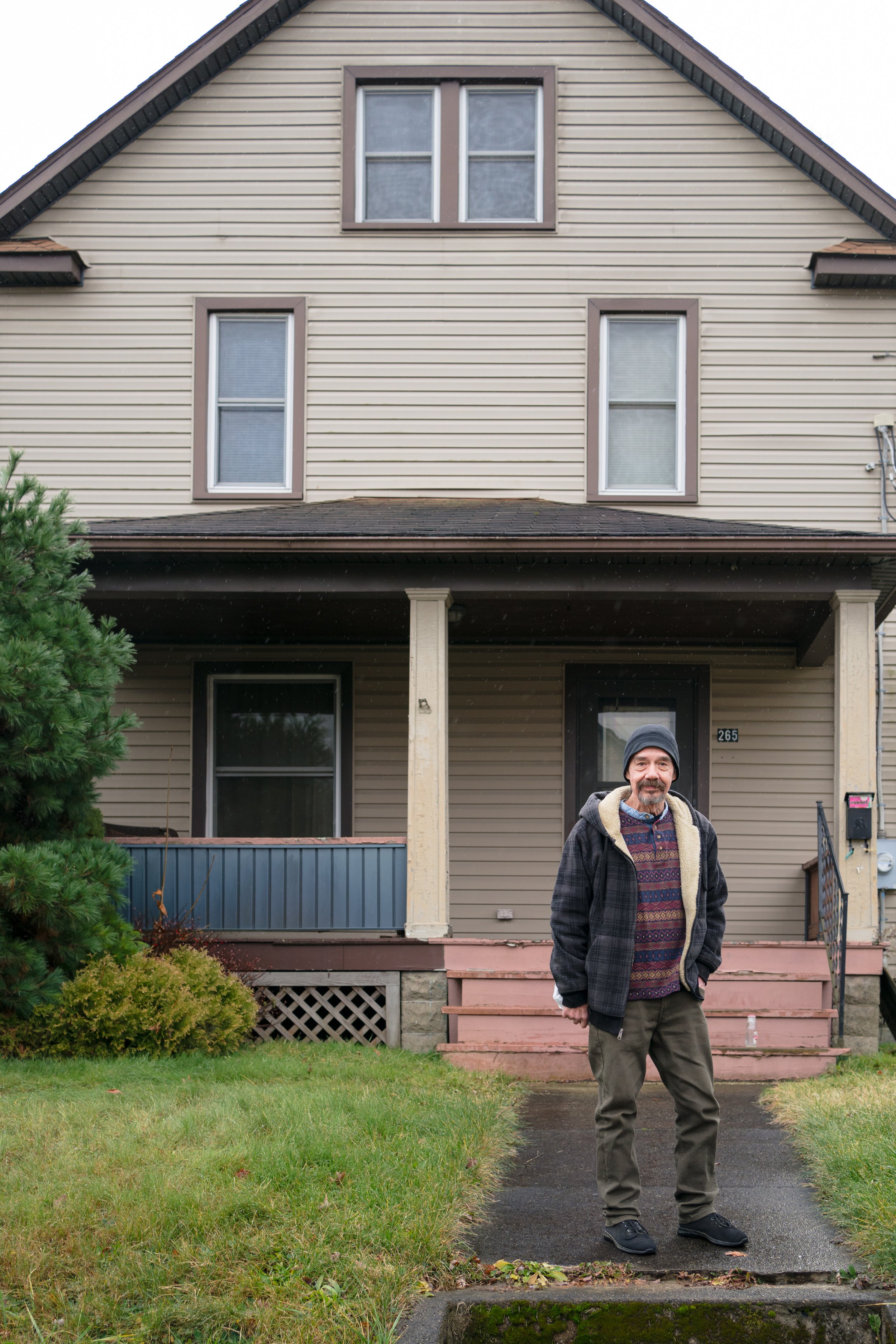‘A humming in the background’: Trauma in the aftermath of the East Palestine train derailment
By Dani Brown, Director of Strategic Communication at RiverWise
Heart failure never held back Rob Two-Hawks from living his fullest life.
Rob has been an avid organic gardener for more than 50 years. He enjoys walking the streets of East Palestine multiple times a week to chat with neighbors, run some errands, and stay as active as possible. It’s part of his wellness — being a good neighbor, going on walks, and doing lots of writing in his spare time.
Rob has an unusual heart condition. Known as mitochondrial cardiomyopathy, he said only a small number of cardiologists in the country treat the disease. Despite his illness, Rob kept on moving until February 3, 2023, when a Norfolk Southern train derailed in East Palestine, Ohio, and wreaked unimaginable havoc on the small town just along the border between eastern Ohio and southwest Pennsylvania.
A freight train derailed at roughly 9 p.m. on a Friday night in February. The train was carrying cargo from Madison, Illinois, to Conway, Pennsylvania. Approximately 20 of the more than 100 train cars housed hazardous chemicals, according to reporting from the Associated Press, including 14 carrying vinyl chloride. The chemicals in those cars were later emitted into the air through a “controlled release.” The delayed chemical release was intended to mitigate a potential explosion, experts said at the time.
The train derailed a half-mile from Rob’s home. He witnessed the smoke and fire that enveloped the sky following both the derailment and release.
“Three quarters of the sky was covered,” Rob said. “So that gives you some sense of what was hovering over and how wide of an area. And then it kept moving, of course.”
“And then things got interesting for me,” he added.
Just two days following the chemical release, the community was told all was well by Ohio Governor Mike DeWine and the state Environmental Protection Agency. The water, soil, air — everything — was declared safe. Residents who were told to evacuate could return.
Rob trusted the authorities and did as instructed. He started on his weekly walk to town, acting as normally as he could knowing a train exploded nearby. But something was different as he started his walk. He didn’t feel quite right.
“I was stopped like I hit a stone wall,” Rob said. His body just said, “No.”
“I love to walk,” he added. “I walk downtown. I don’t go as far or as fast because of the heart failure. But I usually head down three times a week. Just two days after the derailment, I couldn’t get there. I couldn’t do it.”
Before the derailment, he’d typically walk roughly three-fourths of a mile to the downtown area. He said he could walk down the road just fine prior to Feb. 3, and sometimes he’d take two or three stops on the way home to make the trip a little lighter.
“But two days after the derailment, I couldn’t get a block downtown,” he said. “I tried again in a few days; I tried again in a week. Then, I said, ‘I can’t do this.’”
Rob hasn’t been able to walk his normal distance since. That was roughly 10 months ago.
‘It’s been traumatic.’
Residents affected by the East Palestine train derailment never expected the past year to go the way it has. While the train derailment itself was traumatic enough, the aftermath has continued to have ripple effects that could be lifelong.
“It is a fight to get attention,” Rob said, “to get the unmet personal and community needs taken care of, especially when (we) feel that so many others have failed (us).”
Zsuzsa Gyenes is one of the fighters.
Since April 2023, Zsuzsa and her son have lived in a hotel room in Cranberry Township.
For the two months following the derailment, she lived in multiple hotels because pollution seemed to follow her wherever she landed.
After the train derailed, she and her son evacuated to Chippewa Township, Pennsylvania, roughly 10 miles from East Palestine. But when the chemical release occurred, she wanted to move farther away, as some reports showed the plume could travel many miles. She didn’t want to risk it.
So, she ended up in a hotel in Center Township — one of the few places that would allow her to stay longer-term with pets.
But on Feb. 13, just ten days later, Shell’s ethane cracker plant in Potter Township, less than a mile from her Center Township hotel, malfunctioned, resulting in a flaring event that could be seen from more than 25 miles away. That incident was one of dozens of violations produced by the plastics plant in only four months of being operational.
Zsuzsa knew she couldn’t stay. She couldn’t risk her son breathing in more toxic air. She eventually landed in Cranberry Township, where she, her son, and their two cats have lived since the spring.
Living in a hotel has been maddening at times, Zsuzsa said.
“With our two cats and my son, who is very active, we’ve got his bike in here and everything else. It was very cramped and felt like we were on top of each other, and we still kind of do,” she said. “I just want to go back to a normal house. I didn’t choose to live in a hotel. And it’s stressful to think everyday about how we’re not back to normal. We’re just still misplaced.”
It’s been traumatic for Zsuzsa and her family for many reasons, especially the unpredictability of the day-to-day. In addition to displacement, her son continues to have a bizarre rash that won’t go away. It’s a rash he never had prior to the derailment.
“Federal poison control told me that our symptoms match an allergic reaction to a chemical irritant,” she said. She was given instructions to go to her primary care physician, but she said she hasn’t received answers.
She feels helpless.
“We just were getting turned down and it felt like there was nowhere to turn to. My son keeps getting this rash on his face that he’d never had before the derailment. It can’t be explained by anything else right now. It just comes and goes, and they don’t know what it is,” she said. “How do you just live with that?”
“It’s dehumanizing,” she added.
Even the act of moving away has created trauma for her and her son, and many others affected by the derailment. The lack of security and familiarity are at times too much.
“Some people have lived there (in East Palestine) for 60 years or for generations… That’s traumatizing to believe that everything’s just gone. It’s like watching your whole planet get blown up,” Zsuzsa said.
And as a mother, Zsuzsa wonders how to explain the complexities of the situation to her son while still making him feel safe and heard.
“It’s hard as a mom to try to explain it, too, because it’s like, am I supposed to tell him he’s not supposed to trust the government? I don’t want him to feel like you can’t trust anybody. It’s hard to navigate. I just don’t want him to feel afraid, and I don’t want him to feel powerless,” she said.
Candice Desanzo knows what powerlessness can feel like.
The mother of five lives in her childhood home in East Palestine. After the train derailed, Candice and her family stayed home for about four weeks. But in the wake of the derailment, her children started getting sick, which was rare, she said.
“My kids had never been sick, ever. The one and two year old never had an ear infection, never had a cough, nothing,” she said.
But while staying in her home, Candice said, “I had them at the pediatrician, probably two or three times a week, because these kids could not breathe. Every time I’d wake them up in the morning, they’d have drool with blood pooled in the drool.”
She and her family — including her cat and two dogs — briefly moved out of town to escape sickness. For residents within a one-mile radius, Norfolk Southern offered to pay for relocating families. But those affected families had to front the costs.
“We lived in Airbnbs, hotels, and we actually had to bring a trailer when we’d have to move from place to place because in order to maintain life somewhere with that many children, it’s no easy task,” Candice said.
She returned home because she felt almost forced to.
“I felt like I was forced back home because (Norfolk Southern wasn’t) giving me viable options to maintain a stable life outside of living in my home. They wanted me to stay in a hotel. But you can’t stay in a hotel room with two 70-pound dogs, a cat and four kids,” she said.
Since she returned, she’s been fighting for the health and safety of her children and all those affected by the derailment.
“If I turn a blind eye to what is going on here, I fail my children,” Candice said.
Trauma can be like ‘a humming in the background’.
Dr. Maureen Lichtveld is Dean of the University of Pittsburgh School of Public Health. She has conducted research that examines the cumulative impact of chemical and non-chemical stressors on communities facing environmental health threats, disasters, and health disparities.
Since the 9/11 terrorist attacks in New York City in 2001, Dr. Lichtveld has held leadership roles in research and practice related to disaster preparedness and disaster management. In her extensive research and practical experience, she said trauma doesn’t come out of nowhere, but it can take time to show up.
“In some people — not everybody — but in some people and I particularly worry about in kids, it’s like a humming in the background. Something very little could trigger it again,” Dr. Lichtveld said. “For example, if a child has to move again or change schools again.”
During her research in Louisiana after Hurricane Katrina in August 2005, she and her team found the number one reason children ended up in the emergency room was due to mold exposure that exacerbated their asthma. But the second reason was much different.
“The second most reason (the children) had exacerbation and needed to visit the emergency room was because they lost a pet or they changed schools more than twice in a year,” Dr. Lichtveld said. “So, these are the triggers that can happen over time.”
The emotional trauma of losing a pet or being forced to change schools again brought up physical symptoms in many of the children impacted by the hurricane. Trauma can take a while to kick in for some folks, especially for the most vulnerable, like children, but the potential for a trauma-response is always there.
Being forced to move out of town is much more traumatic than one might assume.
For a close-knit, family-centered community like East Palestine, Dr. Lichtveld said that forced migration is exceptionally traumatic.
“There’s only 1% mobility out of that community,” Dr. Lichtveld said. “Meaning this is really their home. You don’t move away. So, moving away is an example of a very traumatic experience.”
She called this a loss of “cultural cohesion.”
“If my grandparents and my great-grandparents and my parents all have grown up in the same home or in the same area, and now all of a sudden I have to move away, I’m losing what’s called ‘cultural cohesion.’ That’s a strength of the community,” Dr. Lichtveld said. “If you lose cultural cohesion and it happens very often, this forced migration — that moving away, not planned, not voluntary — can have a tremendous impact on both people’s physical health, but also particularly their mental health.”
This sort of un-gluing of the family unit has long-lasting effects for all members of the family. It also can fracture the cultural dynamics and strengths of the village of East Palestine.
Jami Wallace, a life-long East Palestine resident, had nearly 50 family members living within a 1-mile radius. That was before the derailment. Now, her family members are displaced, including her mom and step-dad.
“When you talk about the things Norfolk Southern has taken,” Jami said through tears, “they took away my family.”
Many studies have been conducted examining residents’ mental health following exposure to a community disaster. A 2020 study published in Chonnam Medical Journal looked at disasters around the globe.
The writers concluded that the “prevalence of PTSD (post-traumatic stress disorder) after a community disaster based on recent studies ranges widely from 3.6% to 37% among disaster-affected community residents.”
Following the logic of that study, one would expect that anywhere from 171 to 1,761 residents of East Palestine could experience PTSD or similar symptoms. And that’s not including residents outside of the municipal limits who have reported significant symptoms post-derailment.
In fact, in April 2023, the Ohio Department of Health surveyed 534 local residents after the derailment. More than 61% of those surveyed reported experiencing anxiety.
But as Dr. Lichtveld said, trauma can show up later on.
Rob knows what that’s like.
‘Crisis is opportunity.’
Rob suffered a severe trauma as a teenager back in the 1960s that resulted in a traumatic brain injury. He calls himself a “veteran of the trauma wars” and was diagnosed with complex PTSD.
His traumatic experience resulted in 25 years of dissociative episodes that lasted for months, and, like clockwork, occurred every fall and winter. He was unable to finish college, and says it’s the reason he never got married, settled down, and had lapses in employment.
“How many employers are going to keep somebody that’s off work for two months?” he said.
When his dissociative episodes were especially severe, Rob said he would have to relearn how to read, write, and talk again.
Through his trauma, as well as a near-death experience being caught in a riptide with no one to aid him, Rob knows a traumatic situation when he sees or experiences one. And what happened in East Palestine certainly constitutes a community trauma, he said.
“Has this been traumatic? I can say, ‘Yeah, from all my experience,’” Rob said. “I’ve got everything under my belt to deal with it, except for, I’m older; I’m beat up. And now, I’m getting all the symptoms downline before this derailment and toxic fire and the impact of all those years of PTSD because it takes a toll on the body.”
Rob said when people go through a crisis or some unforeseen traumatic event, they develop a special capacity out of necessity.
“When we begin after trauma, after a cycle of abuse or even one serious abuse — we’re victims. But if we keep going down that highway and take a look at ourselves and stretch and grow and process the emotional intensity that we went through as a key, we’ll turn it into gold. Something will come from it,” he said.
He believes this is a way of turning wounds into gifts, and he’s seen it happen to those affected by the derailment, even in those who haven’t seen it themselves.
“There are gifts on the other side of your PTSD,” Rob said. “The disaster here has opened up a whole bunch of people. It’s just really inspirational to see it.”
Rob said he’s talked with community members who are now advocates, researchers, activists, leaders and more.
“People have discovered the old Chinese saying, ‘Crisis is opportunity,’” he said. “We are all human beings with unbelievable potential.”
Some of those people include Candice and Zsuzsa, who said they refuse to stop fighting for justice.
“I used to be really cynical,” Zsuzsa said. “But the more I see people feeling the same way, feeling the same frustration about things that matter, I realize that we can take that energy instead of just being all salty and depressed about it, we can actually do something with it and make a change. If we all work together.”
Candice said she’s stronger than she thought.
“You feel weak sometimes, you want to give up, but I’ll never give up,” she said. “Because it’s not about me, it’s about my kids. As a mother, you fight to the death for your kids. That’s what we do.”
This piece is apart of Still Here, a project in collaboration with RiverWise
and Clean Air Action Fund.







